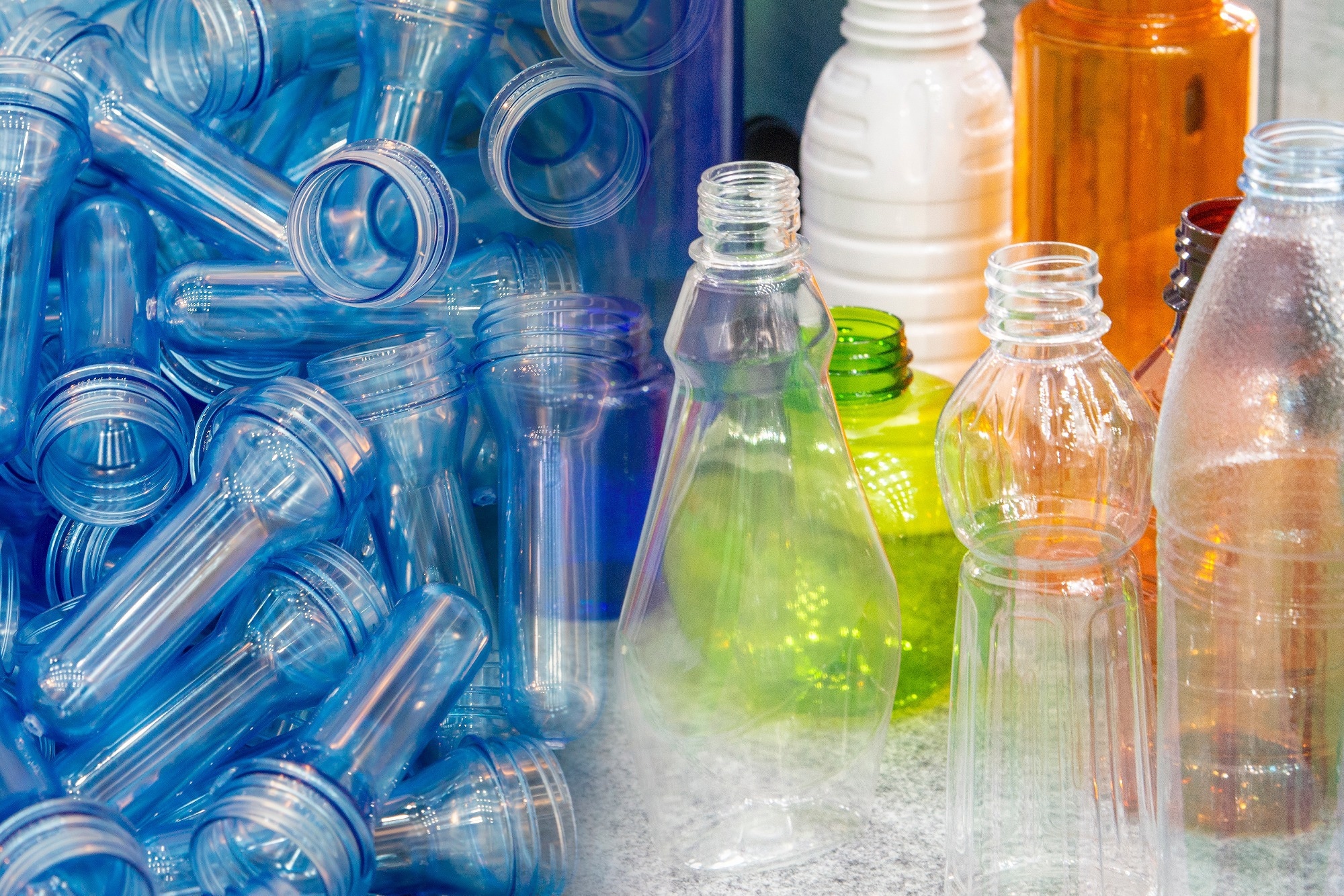 By Taha KhanReviewed by Lexie CornerAug 14 2024
By Taha KhanReviewed by Lexie CornerAug 14 2024Plastics are ubiquitous in modern life, found in everything from household items and packaging to automobiles and medical devices. Their versatility, durability, and cost-effectiveness make them indispensable across various industries. This article explores the different types of plastics, highlighting their distinct properties and applications.

Image Credit: Pixel B/Shutterstock.com
What are Plastics?
Plastics are synthetic or semi-synthetic materials made from polymers, which are long chains of molecules typically derived from petroleum, natural gas, or other organic sources. Plastics are malleable, meaning they can be molded or shaped when heated, and once cooled, they retain their shape and solidify.1, 2
Plastics are generally categorized into two main types: thermoplastics and thermosetting plastics. Thermoplastics, such as polyethylene (PE), polypropylene (PP), and polyvinyl chloride (PVC), can be melted and reshaped multiple times without significant chemical change.
In contrast, thermosetting plastics, like epoxy, phenolic, and melamine resins, undergo an irreversible chemical change when heated, forming a permanent bond that cannot be remelted or reshaped.3, 4
Some examples of thermoplastics and thermosetting plastics are discussed in detail below.
Polyethylene
PE, produced through the polymerization of ethylene, is one of the most widely used plastics. It is known for its versatility and range of applications. PE comes in different forms, including high-density polyethylene (HDPE) and low-density polyethylene (LDPE), each with specific properties suited to particular uses.
For example, HDPE is used for products such as pipes, bottles, and plastic lumber due to its strength and rigidity.2, 5, 6 LDPE, on the other hand, is more flexible and is commonly used in plastic bags and packaging materials.
Polyethylene's resistance to moisture and many chemicals, along with its lightweight and ease of processing, makes it durable and cost-effective for manufacturers.2, 5, 6
Polypropylene
Polypropylene (PP) is a thermoplastic polymer made through the polymerization of propylene. It is widely used in various industries due to its toughness, chemical resistance, and high melting point. These properties make it suitable for applications requiring durability and heat resistance, such as automotive components, electrical housings, and medical devices.2, 4, 7 Its flexibility and fatigue resistance also make it useful in hinges, reusable containers, packaging, textiles, and consumer goods.
While polypropylene is recyclable, challenges in the recycling process persist.2, 4, 7
Polyvinyl chloride
PVC is produced through the polymerization of vinyl chloride and is available in both rigid and flexible forms. PVC is valued for its resistance to chemicals, water, and fire, making it suitable for a wide range of applications.
Rigid PVC, or uPVC (unplasticized PVC), is strong and weather-resistant, making it ideal for construction materials like pipes, window frames, and siding. Flexible PVC is created by adding plasticizers, which make it softer and more pliable, suitable for uses such as electrical cable insulation, flooring, and medical devices like blood bags and tubing.4, 8
Polystyrene
Polystyrene (PS) is a synthetic aromatic polymer made from the monomer styrene. It is widely used due to its rigidity and ease of molding. Polystyrene is available in both solid and foam forms.
Solid polystyrene is often used for applications like disposable cutlery and laboratory equipment because it is clear, hard, and brittle. Expanded polystyrene, commonly known as styrofoam, is lightweight and offers excellent insulation properties, making it ideal for packaging, thermal insulation, and disposable cups and trays.2, 9
Plastic: Environmental Impact and Sustainable Solutions
The most significant challenge posed by plastics is their environmental impact, as most plastics are not biodegradable and can take hundreds to thousands of years to break down. Plastics can fragment into microplastics, contaminating soil, water, and air, posing risks to wildlife and human health. Improper disposal of plastic waste leads to a significant portion ending up in oceans, creating large garbage patches and threatening marine life. Animals can become entangled in larger pieces or mistake plastics for food, leading to injury, starvation, or death.10, 11
Addressing these environmental issues requires a multifaceted approach, including improving waste management and developing sustainable alternatives like biodegradable plastics. Effective waste management systems are crucial for properly collecting, sorting, and recycling plastics, with PET and HDPE having higher recycling rates due to established infrastructure.2,11, 12
Biodegradable Plastics
The future of plastic production lies in enhancing sustainability through innovation, improving recycling technologies, and developing biodegradable plastics. Biodegradable plastics, made from natural materials like corn starch or sugarcane, are designed to break down more quickly under specific conditions, reducing their environmental impact.
A 2022 study highlighted advancements in biodegradable plastics, emphasizing their potential to address environmental concerns associated with traditional plastics.13
The study included a lifecycle assessment of biodegradable plastics, noting that these materials can offer properties similar to conventional plastics while reducing environmental impacts, particularly carbon dioxide emissions. It also emphasized the importance of proper waste management practices, such as composting, to maximize the benefits of biodegradable plastics.
The study also underscored the growing academic and industry interest in these materials and the need for a sustainable framework to enhance their long-term viability.13 By understanding the different types of plastics, their properties, and their environmental implications, we can make more informed choices and contribute to a more sustainable future.
More from AZoM: Understanding the Plastic Biodegradation Process
References and Further Reading
- Gilbert, M. (2017). Plastics materials: Introduction and historical development. Brydson's plastics materials. doi.org/10.1016/B978-0-323-35824-8.00001-3
- Lichtig, A., Conniff, M. (2024). All About Plastic: Definition, Types and Applications. [Online] Xometry. Available at: https://www.xometry.com/resources/materials/what-is-plastic/ (Accessed on 09 August 2024)
- Twi-Global. (n.d). Thermoset vs Thermoplastic (What is the Difference?). [Online] Twi-Global. Available at: https://www.twi-global.com/technical-knowledge/faqs/thermoset-vs-thermoplastic (Accessed on 07 August 2024)
- A&C Plastics.inc. (n.d.) 7 Different Types of Plastic. [Online] A&C Plastics.inc. Available at: https://www.acplasticsinc.com/informationcenter/r/7-different-types-of-plastic-and-how-they-are-used (Accessed on 07 August 2024)
- Kanagaraj, S., Varanda, FR., Zhil’tsova, TV., Oliveira, MS., Simões, JA. (2007). Mechanical properties of high density polyethylene/carbon nanotube composites. Composites Science and Technology. doi.org/10.1016/j.compscitech.2007.04.024
- Jordan, JL., Casem, DT., Bradley, JM., Dwivedi, AK., Brown, EN., Jordan, CW. (2016). Mechanical properties of low density polyethylene. Journal of dynamic behavior of materials. doi.org/10.1007/s40870-016-0076-0
- Maddah, HA. (2016). Polypropylene as a promising plastic: A review. Am. J. Polym. Sci. DOI: 10.5923/j.ajps.20160601.01
- Ait‐Touchente, Z., Khellaf, M., Raffin, G., Lebaz, N., Elaissari, A. (2024). Recent advances in polyvinyl chloride (PVC) recycling. Polymers for Advanced Technologies. doi.org/10.1002/pat.6228
- Tseng, PC., Chu, HS. (2009). An experimental study of the heat transfer in PS foam insulation. Heat and mass transfer. doi.org/10.1007/s00231-008-0417-1
- Hopewell, J., Dvorak, R., Kosior, E. (2009). Plastics recycling: challenges and opportunities. Philosophical Transactions of the Royal Society B: Biological Sciences. doi.org/10.1098/rstb.2008.0311
- North, EJ., Halden, RU. (2013). Plastics and environmental health: the road ahead. Reviews on environmental health. doi.org/10.1515/reveh-2012-0030
- Filiciotto, L., Rothenberg, G. (2021). Biodegradable plastics: Standards, policies, and impacts. ChemSusChem. doi.org/10.1002/cssc.202002044
- Moshood, TD., Nawanir, G., Mahmud, F., Mohamad, F., Ahmad, MH., AbdulGhani, A. (2022). Sustainability of biodegradable plastics: New problem or solution to solve the global plastic pollution?. Current Research in Green and Sustainable Chemistry. doi.org/10.1016/j.crgsc.2022.100273
Disclaimer: The views expressed here are those of the author expressed in their private capacity and do not necessarily represent the views of AZoM.com Limited T/A AZoNetwork the owner and operator of this website. This disclaimer forms part of the Terms and conditions of use of this website.